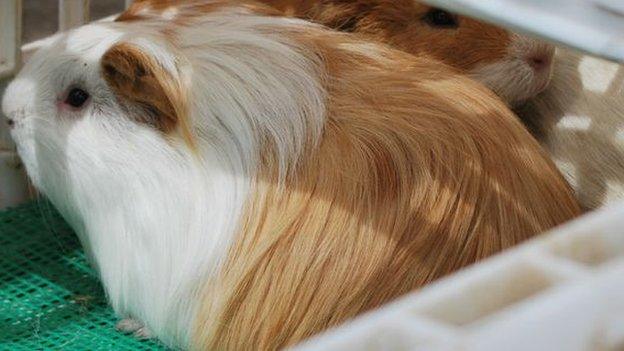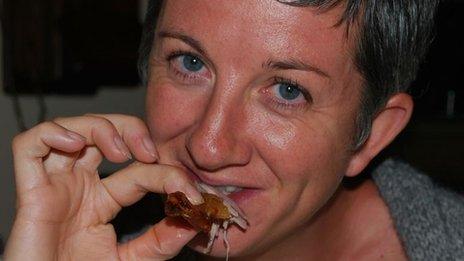Could I bring myself to eat a guinea pig?
- Published

Eating roasted or fried guinea pig is an ancient tradition in parts of South America, and still common today. But in other parts of the world the rodents are cherished as cuddly, fluffy pals for children. How do you make the mental leap from cute pet to delicious meal?
As a committed carnivore I'm not in the habit of attaching personalities to the meat on my plate.
But this was a guinea pig, with four legs, a face and endearingly prominent front teeth. I used to have one as a pet.
My husband Jeremy and I were in a restaurant in southern Ecuador, where guinea pigs are regularly served up with potatoes and corn, and have been for thousands of years. Peru, Bolivia and parts of Colombia also do so.
We'd seen them being cultivated in a small rural home in Colombia, and impaled on thick rods before being roasted en masse in an Ecuadorian market. Eating traditional foods is a large part of the travel experience, so there was no way we would pass through the region without sampling this dish.
The roasted guinea pig - called cuy in South America - was brought to our table whole before being chopped into five pieces - four leg portions and the head.
I considered Jet, the tufty black guinea pig who was my first pet. He was forever getting lost and his antics were the subject of a story written by eight-year-old me, which won a local writing competition.
That he died in the care of friends while we were on holiday - overwhelmed by the car fumes in their garage - was one of those dramatic childhood turning points that I never really got over. Could I move on?

Paula Dear tucks into a plate of "cuy"
The reaction from some of our friends on social media to our planned meal suggested cuy-eating might not become popular any time soon in Europe, where guinea pigs have been loved as pets since traders introduced them in the 16th Century.
When British TV presenter Philip Schofield tweeted about eating a guinea pig in Peru last year, he was criticised online and in newspapers, including a Daily Mail story with the headline: "TV presenter blasted for boasting about scoffing 'pet'.", external It quoted Animal Aid director Andrew Tyler as saying: "This callous provocation is despicable."
Briton Christopher Breen, who owns restaurant Cafe Eucalyptus in Cuenca, Ecuador, and serves guinea pig tikka masala, says there is little chance of his compatriots adding the animal to their weekly shop.
"Cuy catching on in the UK? I don't think so," he says.
It's a line that many who are well-integrated into Ecuadorian society refuse to cross.
Gary Sisk, 64, from California, retired to Cuenca 18 months ago and has otherwise embraced the local culture, but says he has no intention of eating a guinea pig.
"When I first noticed cuy roasting in the market I was kind of shocked because of course we had them for pets as kids," he says.
"My Ecuadorian friend is always putting one in the cart when we go shopping. Of course they laugh at my reaction when I see one, because they have eaten them all their lives."
There have been small-scale exports of the delicacy to the US, Japan and some parts of Europe - often at the behest of the Latin American diaspora - but consumption levels are unlikely to reach those of Peru, for example, where an estimated 65 million guinea pigs are eaten annually. Far higher quantities of chicken are eaten - more than 500 million per year - but guinea pig remains preferred for special occasions.
It's in Peru that archaeologists report guinea pigs were first domesticated as a food source as early as 5,000 BC, prized for their high protein levels and - although the fat content is relatively low - as a source of fat.
They later became an integral part of religious ceremonies and folk medicine. To this day they are often the centre of local festivals, which are considered to be incomplete without cuyes.
Their significance in Andean society is famously acknowledged in Peruvian-influenced depictions of Christ's Last Supper, in Lima and Cusco.

But it's not all about the past. Cuy is still a popular animal to cultivate in rural and urban homes for eating on special occasions or - as they fetch a relatively high price - selling in markets or to shops. Larger-scale production also exists, often focusing on restaurants and the small export market.
Indeed, some argue animals like this could be the future. Guinea pigs reproduce fast, taking up very little space and efficiently processing their simple diet of grass and vegetable scraps.
Raising cattle is a drain on resources, they point out. By comparison, guinea pig, squirrel, and other rodents are "low-impact protein sources".
Matt Miller, a science writer for the US-based Nature Conservancy, is writing a book about the benefits of eating "unconventional" meats.
"Many animals that some consider 'bizarre' or 'unconventional' make a lot more sense - ecologically, economically, personally - to eat than modern, industrial meat," he says.
Miller focuses on a number of rodents that are "abundant and can be sustainably harvested", like squirrels, capybaras - the world's largest rodent, also eaten in Venezuela - and guinea pigs.
He concedes the "cultural aversion" to eating animals like guinea pigs is "huge" in many countries.
Could those who have only ever seen guinea pigs as companions ever make that leap?
Miller adds: "It's not going to replace beef. But diets can and do change over time. I grew up hunting and eating squirrel - many rural Americans still do. There is a growing interest in many countries in food diversity, so I don't think the idea of eating guinea pigs is completely hopeless."
Back at the restaurant, we wondered who would take the first bite.
Jeremy was a vegetarian for 27 years until 2010, but has approached meat-eating with the scary zeal of a convert.
He grabbed the first piece. Delicious. The marinade and slow roasting process, involving regular basting, had given it a tasty crackling-like skin, while the dark gamey meat was rich and oily, not unlike rabbit.
Guilt tinged my enjoyment a little - just a little. I drew the line at tackling the head - popular with locals - while the ex-vegetarian devoured it.
You can follow the Magazine on Twitter, external and on Facebook, external